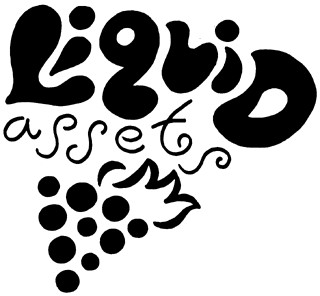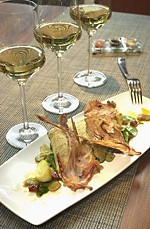Liquid Assets
Australian Shiraz
By Wes Marshall, Fri., Sept. 22, 2000

Looking for an exciting wine for a special occasion? Or a wine that will bewilder your guests? How about one that won't break the bank? Shiraz, the classic red wine of Australia, may be the ticket. It is generally massive, intensely fruity, and smooth enough so that almost anyone will enjoy it, wine lover or not. The flavor tends to be rich and peppery with a syrupy feel in the mouth. When it comes to utter epicurean enjoyment, few wines can match Shiraz. Even better, since it is just now growing in popularity, not established like Cabernet or Merlot, it is still relatively inexpensive.
Shiraz was born as the noble Syrah grape from the Rhone Valley in France. It showed up in Australia during the 19th century. Today, Shiraz accounts for over 40% of all the red wine grapes grown there. Shiraz is so widely grown that, in the past, Aussie winemakers supposed it was an inferior grape, and it was often compared to Cabernet. In Australia, given the local growing conditions, Shiraz is capable of producing better wine than Cabernet, Pinot Noir, or Merlot.
A note on the temperature of the wine: "Red wine at room temperature" is a European concept in which the rooms are much cooler than they tend to be in Texas. Shiraz is happiest at about 65-70 degrees. Above that, it thins out and becomes more acidic. If your wine is sitting in your kitchen, there is a good chance it's about 80 degrees, which will make it taste yucky. Invest a few dollars on a meat thermometer and use it only on wine. Open the bottle. If the wine is above 70 degrees, stick it in the refrigerator until it goes down to 65. Pull the wine out and taste it. As it warms up to 70 and above, you'll see how important the temperature is.
Below is a list of inexpensive Shirazes. It's available in every price range from $7 to $150 per bottle. Shiraz is big, heavy wine that matches perfectly with robust meat and fish dishes. For a great party, try any of the Shirazes below matched with my recipe for Pork Tenderloin with Sun-Dried Tomatoes, Currants, and Walnuts.
D'Arenberg McLaren Vale "The Footbolt" Old Vine Shiraz ($15)
Named for a racehorse from the early 20th century. Winner of several Gold Medals. The current vintage, 1998, is a little young and tart. Leave it in your closet for a year and it will improve.
Buckeley's Shiraz ($10)
Loaded with spicy pepper flavors. Better for quaffing than with food. A friend who normally drinks jug wines loved this so much, he bought a case.
McGuigan Bin 2000 Shiraz ($10)
This wine has strong berry flavors with lots of spice and a long finish. Make sure to get the temperature right. Tied for best of the group. Incredible bargain.
Tyrrell's Wines Long Flat Shiraz ($9)
A lighter style Shiraz. Intense cherry flavor with a nice, long finish and a charming aroma.
Wyndham Estate Bin 555 Shiraz ($10)
Thick, intense, teeth-staining wine. Jammy flavors. Great with food. Big enough to go well with Mexican mole sauces. Tied for best of the group. Correct temp vital.
Grilled Pork Tenderloin with Sun-Dried Tomatoes, Currants, and Toasted Walnuts
Serves 4
1 pork tenderloin (about 11é4 pounds)
1 tablespoon of olive oil
Salt and (preferably white) pepper
3 tablespoons of olive oil
1 medium white onion
2 cloves garlic, crushed
1 cup dry white Vermouth
1/4 cup coarsely chopped sun-dried tomatoes
1/2 cup currants
3 sprigs fresh thyme
1 bay leaf
1 cup toasted walnuts
Heat the olive oil in a sauté pan over medium heat. Dice the onion and place in the pan. Cook until the onion is translucent. Add garlic to onions. Stir to keep the garlic from turning brown. After two minutes, remove pan from heat. Slowly add the vermouth. Add the tomatoes, currants, thyme, and bay leaf to the pan. Add salt and pepper to taste. Return to medium heat. Cook until liquid is reduced by half. Remove from burner.
Rub the tenderloin with one tablespoon of olive oil. Season with salt and pepper. Place on a hot grill. Cook to your preferred internal temperature. Remove from grill. Let it rest for five to seven minutes.
While the pork is resting, reheat the sauce. When you drag a spoon across the bottom of the pan, you should be able to see the pan for a second, and then the liquid should cover the pan again. If the pan doesn't show, you need to cook it down more. If the liquid doesn't cover the pan after you pass the spoon over, add another 1é4 cup of vermouth and cook for 3 minutes at medium heat. After the pork has rested, cut it into one-inch thick pieces and place on a warm platter. Remove the thyme and bay leaf from the sauce. Cover the pork with the sauce, sprinkle the walnuts over the top, and serve with one of the recommended Australian Shirazes above.








